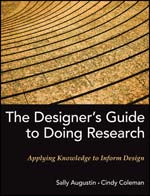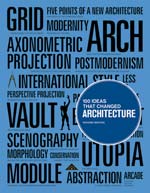
|

|
|
Home Site Search Contact Us Subscribe
|
|
|
Two Books to Accelerate the Translation of Ideas into Practical Forms New books on design research and transformational ideas through architectural history have potent practical uses: "The Designer's Guide to Doing Research: Applying Knowledge to Inform Design" Sally Augustin and Cindy Coleman; and "100 Ideas That Changed Architecture" by Richard Weston By Norman Weinstein February 24, 2012 What do courses on architectural theory do for students beyond prepare them to philosophically bemuse themselves, maybe just space out, in a charmingly escapist manner during un- or under-employment? Cynical? A bit, but I’m posing the question also fuelled with genuine curiosity. Behind that question lurks a far more sweeping query: what constitutes actionable architectural knowledge? And how can future architects learn how to create a profitable practice using such knowledge?
The literature comprising architectural theory continues to blossom at a rate far exceeding architectural job opportunities because theories, unlike opportunities, propagate with the speed of computer viruses. And ideas, those building blocks constructing theories, grow likewise. My blue-collar Old Man’s credo was terse about such matters: “Ideas are cheap” was his retort when his usual mantra of “Talk is cheap” seemed too light a touch. So the recent publication of The Designer’s Guide to Doing Research: Applying Knowledge to Inform Design (Wiley, 2012) didn’t initially set my pulse racing. Written by Dr. Sally Augustin, an environmental psychologist, and Cindy Coleman, a design strategist with Gensler, I anticipated some irrelevant academic tract detached from architecture’s real-world economic woes, and the occupation’s current and prolix identity crisis. Research? How can small to mid-size firms even entertain the idea of research when the daily reality involves how to pay the bills?
But Augustin and Coleman are savvy in all matters, except for goofing on the dull title of their lively tome. How can you not love authors standing behind so pedestrian an academic book title that opens with:
Research alone is not all that important ... does not acquire real power until it is integrated with conscious and unconscious knowledge. Knowledge combines professional experience, abstract knowledge, common sense, and inspiration. Knowledge becomes intensely valuable when it can lead to an insight that inspires the resolution of an unanswered question.
So research, whether programmed within an architecture school or activated within an established professional practice, acts as a grand solidifier of an ever-evolving knowledge foundation. Note how simply and succinctly they present architectural knowledge as a four-layer cake composed of know-how derived from actual experience on the job, abstract (theory-laced) knowledge, good sense, and epiphany. So a deep and wide working knowledge of architectural theory matters – as long as theory is well integrated simultaneously with the three other layers of design knowledge, all layers of knowledge coming into active and focused play as project-specific questions arise in daily practice.
Given this model of architectural research and knowledge, the authors do an invigorating job of offering illustrative real-world cases when forceful and ingeniously conceptualized research was completely essential to a complex project’s success. The book offers a tremendous assortment of research tools, ranging from finely-tuned versions of familiar client survey preference forms to plans for innovative on-site charrettes and keenly focused post-occupancy evaluations. This book transfigures totally the notion of architectural research as a mildly cogent add-on to daily practice, illuminating it to be crucial to creative design. Augustin and Coleman reinstate a cogent idea of the philosopher Alfred North Whitehead who wrote long ago: “Education is the acquisition of the art of the utilization of knowledge.” This is a bravura and long-overdue publication about architectural research as an art you can’t afford to bypass.
At first glance, Richard Weston’s 100 Ideas That Changed Architecture (Laurence King Publishers, 2011) looks like one of a dozen introductions to architecture for common folk, unique simply because it tackles its titanic subject through key transformative ideas rather than through the usual timeline-bound parade of key architects and their designs. But Weston’s book is far more intellectually substantial, as well as entertaining, than that. His introduction tosses out a provocative curve ball:
It will be readily apparent from the index that this is not a contribution to the burgeoning genre of architectural theory. Surprisingly few of the ideas are philosophical or theoretical in character; indeed, some readers may wonder whether some of them – like Fireplace with which the book begins, and Wall and Brick which quickly follow – are ideas at all ... It takes only a few moments’ reflection to realize that many of the most potent ideas that have changed architecture are of this seemingly prosaic character.
By offering 100 foundational architectural ideas – stepping back from how ideas work in complicated theoretical frameworks – Weston opens 100 doors into tackling the various forms of research Augustin and Coleman propose as essential for imaginative design. Between projects and looking for an exercise to keep your designing mind nimble? Open Weston’s book at random, and you’re connected to a powerful idea worth researching in-depth. And any of his key ideas possess hefty real world consequences.
This is a catalogue of actionable architectural ideas on a continuum from the abstract (“Postmodernism”) to the most concrete (“Window”). Surrounding his terse yet never oversimplified commentaries analyzing these key ideas are stunning graphics illustrating how these ideas have been materialized. Every idea in Weston’s large-format text enticingly invites design research on multiple levels, with images of iconic projects reminding us of the magical process of what ensues when potent ideas are put into high-velocity transit and translated through construction into brilliantly designed, materialized miracles enriching our days.
Norman Weinstein writes about architecture and design for Architectural Record, and is the author of “Words That Build” – an exclusive 21-part series published by ArchNewsNow.com – that focuses on the overlooked foundations of architecture: oral and written communication. He consults with architects and engineers interested in communicating more profitably; his webinars are available from ExecSense. He can be reached at nweinstein@q.com.
More by Weinstein:
A Meditation on the Beauty of Zaha Hadid's Door Handle Hadid's design issues a challenge: define beauty by lyrically playing with illusion.
Why
"Greatest Hits" Lists by Architecture's Stars Should Be Mocked
Celebratory Meditations on SANAA Winning the Pritzker Prize
Op-Ed: Life After Ada: Reassessing the Utility of
Architectural Criticism
Book Review: How to
be a Useful Architectural Critic: Alexandra Lange's Perspicacious Primer Points
the Way
Michael Sorkin:
Architectural Critic as Scam Scanner and Urban(e) Design Sage
Best Architecture
Books of 2011
Book
Review: Pencils that Refuse to Die: Meditations about New Books on
Architectural Drawing
Book
Review: "One Million Acres & No Zoning": Lars Lerup's Outrageous
Encomium to Houston Instructs and Infuriates
Book
Review: Talkin' 'Bout (Not) My Generation: Uplifting Gen X Architects Showcase
Pragmatic Optimism
"Frank
Lloyd Wright's Guggenheim Museum": Bravura Example of an Architectural
Documentary - Wright's Guggenheim Done Right
Book Review:
Diving into Architecture from Every New Angle: Reading Guillevic's
"Geometries"
Book
Review: "Immaterial World: Transparency in Architecture": Marc
Kristal crystallizes increasingly complex notions of transparency with a light
touch.
Book
Review: "Visual Planning and the Picuresque" by Nikolaus Pevsner.
Edited by Mathew Aitchison
Book
Review: How New Urbanism's Case Triumphs Best Through "The Language of
Towns & Cities: A Visual Dictionary" by Dhiru A. Thadani
Best Architecture
Books of 2010
Book Review:
"Architecture and Beauty: Conversations with Architects about a Troubled
Relationship": Yael Reisner exuberantly interviews architects about beauty
Book
Review: Shedding Light on Concrete: Tadao Ando: Complete Works 1975-2010 by
Philip Jodidio
Book
Review: Sage Architectural Reflections from Architecture's "Athena":
Denise Scott Brown's "Having Words" distills a lifetime of theorizing
and practice into practical and succinct guidance for thriving through
difficult times
Book
Review: Keeping the Architectural Profession Professional: "Architecture
from the Outside In: Selected Essays by Robert Gutman" celebrates Gutman's
legacy as invaluable outsider
Book
Review: "Design through Dialogue: A Guide for Clients and
Architects," by Karen A. Franck and Teresa von Sommaruga Howard
Twilight Visions: Vintage Surrealist Photography Sheds
New Light on Architecture
Best
Architecture Books of 2009
Book Review: "Gunnar Birkerts: Metaphoric Modernist" by Sven Birkerts and Martin Schwartz A major architect in the history of Modernism finally receives recognition – and sundry asides about why Modernism never exited.
Book Review:
"Urban Design for an Urban Century: Placemaking for People," by Lance
Jay Brown, David Dixon, and Oliver Gillham
Book Review:
"Everything Must Move: 15 Years at Rice School of Architecture
1994-2009"
Book Review: A Subversive Book Every Architect Needs:
"Architect's Essentials of Negotiation" by Ava J. Abramowitz
Book Review: A Perspective from One Elevation: "Conversations With Frank Gehry" by Barbara Isenberg Gehry's conversations offer portraits of an astute listener as well as talker, an architect as aware of his flaws and limitations as of his virtues.
Best Architecture Books of 2008
Book Review: You've Got to Draw the Line Somewhere A review of Drafting Culture: a Social History of Architectural Graphic Standards by George Barnett Johnston
Book Review: "NeoHooDoo: Art for a Forgotten Faith," edited by Franklin Sirmans Sharpen your pencils - and get ready to do a NeoHooDoo shimmy. |
(click on pictures to enlarge) 

|
© 2012 ArchNewsNow.com